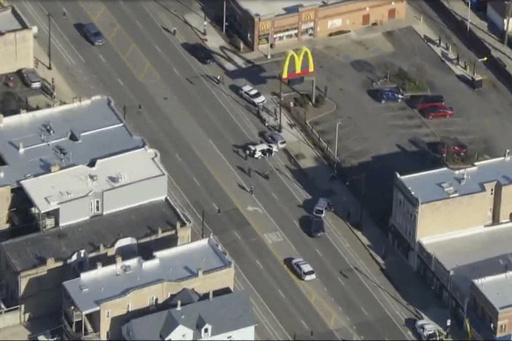CHICAGO (AP) — A deadly traffic stop where plainclothes Chicago police officers fired nearly 100 shots in under a minute has raised serious questions about the use of force and role of tactical officers in departments.
As family and community members mourn 26-year-old Dexter Reed, a police oversight agency and Cook County prosecutors are investigating.
Here’s a deeper look:
‘GRAVE CONCERNS’
Videos and documents released this week by the Chicago Office of Police Accountability paint a harrowing picture of what happened during the March 21 traffic stop.
But about a week ago, the oversight agency’s leader expressed “grave concerns” about the officers’ actions in a letter to Police Superintendent Larry Snelling.
Officers in an unmarked police car stopped Reed for not wearing a seatbelt, according to COPA. But things devolved quickly as he appeared to refuse officers’ commands and didn’t immediately leave the SUV, according to video.
Reed fired first, according to COPA, leaving an officer with a wrist injury. Then four officers fired 96 shots in a span of 41 seconds, including after Reed exited the vehicle, fell to the ground and lay motionless. One officer alone fired 50 shots.
“Based on the totality of the available evidence, COPA has grave concerns about the officers’ ability to assess what is a necessary, reasonable, and proportional use of deadly force,” COPA Chief Administrator Andrea Kersten wrote in an April 1 letter obtained through a records request.
The American Civil Liberties Union also criticized the officers’ actions, including for immediately drawing guns and making profanity-laced commands.
“From the moment they all jump into the vehicle to chase the car, you can feel the adrenaline rush,” said ACLU of Illinois spokesman Ed Yonka. “There were no efforts at de-escalation.”
THE OFFICERS
The officers are on 30-day administrative leave during investigations by COPA and the Cook County state’s attorney.
In her letter, Kersten recommended reevaluating the four officers’ assignments and relieving them of police powers during the investigation.
State’s Attorney Kim Foxx said her office was investigating the possibility of criminal charges.
The officers were part of a “district tactical unit,” according to COPA. Chicago police say tactical officers have been part of each district’s patrol for years. They’re generally sent to areas with high crime patterns, working in uniform and sometimes in street clothes.
Earlier this year, Snelling halted a similar citywide unit, formed during unrest in 2020, that came under fire for sending officers into unfamiliar police districts, among other things.
Elsewhere in the country, elite units of plainclothes officers have faced scrutiny, particularly following the beating and death of Tyre Nichols in Memphis. While police say such units can respond to increased crime, advocates have called out aggressive tactics and traffic stops to search for larger crimes.
Chicago has been under a far-reaching plan for court-supervised reforms since 2019. The U.S. Justice Department had found a long history of racial bias and excessive use of force after police killed teenager Laquan McDonald.
Community activists called the officers to be fired immediately.
Chicago police have declined to comment on the investigation.
THE STOP
Doubts have been raised about whether there was a seat belt violation that led to the stop.
Experts questioned tactical officers’ involvement.
“Why would a police officer, not in uniform, bother with something like that?” asked Geoffrey Alpert, a researcher at the University of South Carolina specializing in high-risk police activities.
Reed’s SUV had dark tinted windows, making it difficult for officers to see inside, Kersten noted in her letter.
“The available evidence calls into question the veracity of this account,” Kersten wrote to Snelling.
Reed’s family members were also skeptical.
“If he was supposedly pulled over for a traffic stop, why did they have four guns pointed at him?” Reed’s sister, Porscha Banks, told reporters after the videos were released. “He was scared.”
Meanwhile, the ACLU pointed to an alarming rise in Chicago traffic stops, which disproportionately affect Black and Latino drivers.
Chicago police reported fewer than 100,000 traffic stops in 2015, compared with more than 500,000 last year, according to advocacy group Impact for Equity.
THE INVESTIGATION
The key to the deadly force investigation will be determining the threat to officers’ lives.
Policing experts raised eyebrows over the number of shots, including after Reed was on the ground.
“All 96 shots need to be accounted for. That means, ‘Why were they fired?’” Alpert said. “The only reason you can fire is if this guy is creating an imminent threat.”
The videos don’t show Reed firing a gun. Police later found a weapon on the passenger side seat of his vehicle.
Footage from body-worn cameras offer glimpses into the confusing and distressing situation, including an officer who applied a tourniquet to a bleeding colleague.
“They don’t know what they’re walking into half the time,” said Ryan Tobiasz, a psychologist who heads a forensic mental health program at Adler University in Chicago.
“They may be highly suspicious, on guard, hyper vigilant,” he said. “Some of them will have a high startle response.”
The police union blamed COPA for pitting the community against police.
Chicago Fraternal Order of Police President John Catanzara said officers “responded heroically” against someone who shot an officer.
“It turned into much more, not because of the officers,” he said in a video statement this week.


